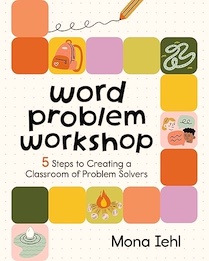What if helping our students is actually holding them back from truly understanding math?
By Mona Iehl

“Ms. Iehl, I don’t get this,” Maddie whispered, her pencil hovering over the page.
I knelt beside her, trying to sound encouraging. “Oh Maddie Girl! I know you can do this. Should I reread the problem so we can talk about where you’ll start?”
She smiled, but then came the familiar plea, “Can you please just show me how to do it? Please. Just tell me what to do.”
Earlier in my career, I would have modeled the steps, waited until she could copy them, and walked away feeling good because I had helped her. Now I knew better: that kind of help doesn’t move students forward. It keeps them standing in the same place.
Months later, Maddie whispered to me again. She wanted to become a teacher. She asked her parents for a teacher clipboard and a “teacher haircut” that looked like mine. My heart swelled knowing she might enter our profession someday.
But the reason Maddie want to be a teacher might surprise you. She saw how I didn’t help make things easier for her. Instead, I helped her help herself. Now, she said, she wanted to grow up and do the same thing for students of her own.
The Teacher’s Dilemma: Why We Want to Help
As a student like Maddie, with teaching aspirations, I studied my teachers not only to learn from them, but to learn how to be a teacher. Being a teacher means helping kids, and it feels unnatural to watch students struggle.
Yet I’ve also spent a lot of time with kids outside of the classroom, watching them learn to hike, make s’mores, and build campfires. Those experiences showed me that we all learn best when we get our hands dirty as we figure things out.
As a student in the classroom that means trying strategies that make sense to us, experimenting with manipulatives and models, and revising our thinking along the way.
Decades of research from Piaget, Dewey, and Vygotsky remind us that children learn best by doing – through hands-on exploration, reflection, and collaboration.
Still, schools face pressure to move fast and follow highly structured programs, even when students need time to make meaning. If our goal is to create independent problem solvers, we cannot always be the ones doing the solving. If I had kept showing Maddie what to do, she might have learned to follow my steps – but not to trust her own thinking.
What Happens When We Help Too Much
“Off you go, friends… solve the problem and be sure to show your work,” I said as my fifth graders began Grapple time during our Word Problem Workshop.
Almost immediately came the chorus:
“Ms. Iehl, I don’t get it.”
“Can you help me?”
“Wait, what are we supposed to do?”
At the same time, a few students pulled numbers from the problem and started adding them together – without reading, reasoning, or even considering whether it made sense.
This is what learned helplessness looks like in math. Students learn the pattern: teacher gives steps → I follow → I’m done. They stop trusting their own reasoning and start looking to us for the “next move.” When that happens, math becomes less about making sense of problems and more about waiting for directions.
And honestly, who taught them that pattern? We did; out of love, out of habit, out of wanting to help.
What Helping Really Looks Like
Helping doesn’t mean giving the next step – it means giving students the confidence and space to find it.
In the Word Problem Workshop I developed for my classroom, students are given the time and structure to grapple: to try strategies that make sense to them, reason through their ideas, and learn from exploring and revising. Then we gather as a class to share and discuss our reasoning, learning from each other’s approaches.
That’s what real support looks like: facilitating and coaching students as they build understanding based on their own experiences and discussions.
The question from educators then becomes, “What does that look like in real classrooms like mine?”
“How can I design a math lesson for students to think, reason, and talk while I support and facilitate?”
Three Shifts from Helping to Empowering
True help means creating the conditions for students to think, reason, and discover what they can do. When we step back, students step up, and these three beliefs help guide that shift from reducing to empowering.
1. Learning Starts with Student Curiosity and Continues Through Honoring Their Expertise
When we jump in too quickly, we send the message that the teacher’s ideas matter more than the students’. But when we honor students’ curiosity, we let their questions and observations drive the learning.
Students already come to us full of mathematical thinking. Our role isn’t to replace that expertise with steps; it’s to recognize, name, and build from it.
Try responding to “I don’t get it” with:
“Tell me what you notice so far,” or “What have you tried that you think might work?”
You’re not rescuing; you’re reminding them that their ideas are the starting point for learning.
2. Mathematical Discourse Builds Understanding and Community
When we do the talking, students stop thinking. When they do the talking, learning sticks.
Students make sense of math through conversation, hearing different perspectives, testing their reasoning, and connecting ideas. Math talk isn’t a bonus activity; it’s the engine of understanding.
Instead of showing the next step, ask questions that invite discussion:
“What makes you think that?” “Can someone build on that idea?”
Each voice adds a piece to the puzzle. As students listen to and challenge one another, they’re not just building math knowledge, they’re building a community of mathematicians.
3. Productive Struggle Is Essential and So Is Our Support
Struggle alone isn’t the goal; productive struggle is. That means students wrestle with ideas, but with enough support to stay in the game.
Helping during Grapple time means giving students dedicated time to try – and the trust and encouragement to express our confidence in their abilities. However, sometimes they might need a nudge in the form of a question or a nugget (a tiny piece of information to help them continue to problem solve). Sometimes that sounds like:
“Take a look back at the chart from yesterday, remember how we modeled the 7 groups of ⅓ with a numberline?”
It’s our job to create a community where students feel safe taking risks and revising their thinking. Just like with Maddie, when we step back and let students take the lead, we see what they’re truly capable of.
What might happen if tomorrow – instead of helping first – you paused and trusted your students to try?
 Mona Iehl is an elementary and intermediate grades educator who transformed her approach to teaching math by embracing student-centered methods that foster curiosity and engagement. She has captured her process in her new book, Word Problem Workshop: 5 Steps to Creating a Classroom of Problem Solvers (Routledge/Stenhouse, 2025). Mona now coaches educators to create inclusive math classrooms where all students develop deep, lasting problem-solving skills. Follow her Math Chat Podcast and connect with her online @HelloMonaMath. Read her other MiddleWeb articles here.
Mona Iehl is an elementary and intermediate grades educator who transformed her approach to teaching math by embracing student-centered methods that foster curiosity and engagement. She has captured her process in her new book, Word Problem Workshop: 5 Steps to Creating a Classroom of Problem Solvers (Routledge/Stenhouse, 2025). Mona now coaches educators to create inclusive math classrooms where all students develop deep, lasting problem-solving skills. Follow her Math Chat Podcast and connect with her online @HelloMonaMath. Read her other MiddleWeb articles here.



